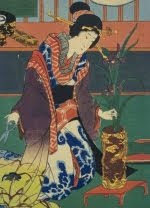These are my contributions to the exhibition "Japan Week 2009 - Beauty and Magic" in the Oslo City Hall Gallery. I'm very proud to be asked to contribute to an exhibition that holds such high quality. It has also been fun to work in a beautiful and well designed setting that compliments the arrangements.
"Pale blue poetry". Painted branches of Mitsumata, Limonium and Aspedistra leaf.
"Ties of friendship". Climbing Hydrangea, Strelitzia and pine in a vase from Nicaragua.
"Between past and future". Wood, Cymbidium orchids and Eucalyptus.
"Inner beauty". Freestyle, Morimono form. Cassava, Cucumber, Kohlrabi and chili pepper


















